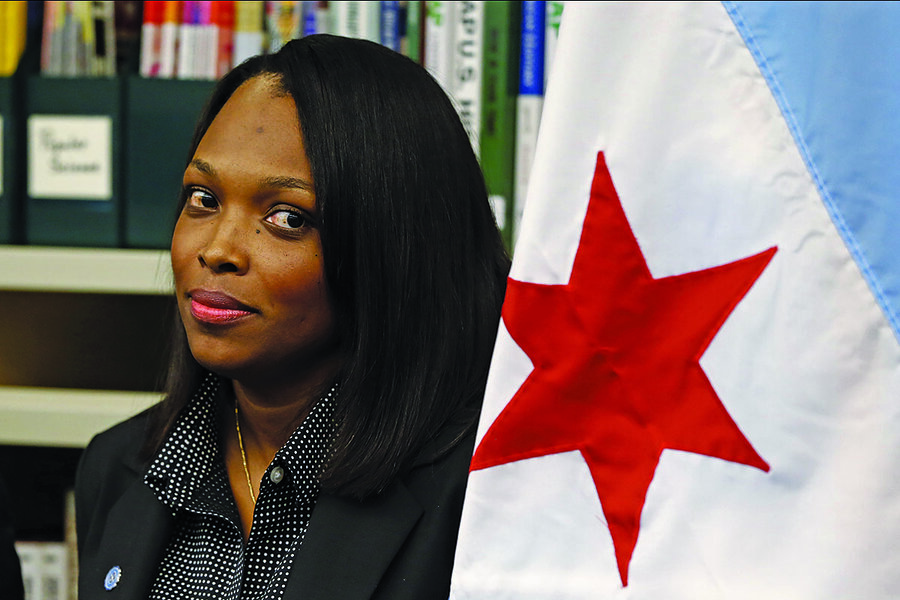Lessons from Chicago: Principals matter in school improvement
Thirty years ago, Chicago’s schools were called the worst in the nation by the US education secretary. The country’s third-largest school district still makes headlines for its challenges, but is starting to be recognized for its achievements, too.
Chicago Public Schools (CPS) is celebrating a more than 20 percentage point increase in high school graduation rates between 2011 and 2017. In the younger grades, the learning happening in CPS between the 3rd and 8th grades is faster than in 96 percent of all US school districts, according to research from last fall that is included a January report by the Joyce Foundation.
Despite heightened scrutiny after a scandal involving graduation numbers in Washington, D.C., education researchers both inside and outside Chicago say improvement in CPS is legitimate, and point to the impressive statistics across grade levels as proof.
“If we see this kind of sustained improvement in a big, low-income district… It suggests there is something real happening,” says Sean Reardon, a professor who studies poverty and inequality in education at Stanford University in California. “It means that there are some lessons we should learn from Chicago.”
It is difficult to say what exactly is driving this progress, adds Professor Reardon, who contributed to the recent Joyce Foundation study and is the author of the research on elementary and middle school gains. However, some observers note that an emphasis on high-quality principals has a lot to do with Chicago’s success.
“Principals are an essential part of school improvement,” says Elaine Allensworth, Lewis-Sebring Director of the University of Chicago Consortium on School Research and a contributor to the Joyce Foundation report. “Schools generally don’t improve without strong leadership or a big structural change or change in student body.”
In Chicago's case, while the demographics of the student body have remained relatively consistent, the focus on principals has sharpened. CPS has worked to strengthen the “principal pipeline” through professional development, such as the Chicago Principal Fellowship, a partnership with Northwestern University, and a new Master Principal Program announced by Chicago Mayor Rahm Emanuel on February 1. The new $600,000 initiative will foster mentorships between new and experienced principals.
The value of such programs appears evident in the low principal turnover in CPS: In 2017, 84 percent of CPS principals remained in their roles, above the national rate, as of 2013, of 77 percent.
Simultaneously, the district’s overall four-year high school graduation rate increased from 54 to 75 percent between 2011 and 2017, with a 20 percentage point improvement among both black and Hispanic students. The average four-year graduation rate in the US is 83 percent. The CPS rates follow a graduation tracking system adopted in 2015, after the district was accused of inflating graduation rates using a limited definition of “drop-out.” CPS defended it as an unintentional statistical error.
An October report from the UChicago Consortium found that the number of CPS students graduating with at least a 3.0 GPA increased 16 percent between 2006 and 2015.
On February 22, CPS became the first school district (of any size) to be named the College Board Advanced Placement (AP) District of the Year more than once, having previously won the award in 2011. The award celebrates the district’s expanded access to AP tests, which often signal college readiness, and improving test scores among every demographic.
Between 2011 and 2017, the number of Chicago high school students taking at least one AP exam increased by almost 44 percent, and the number of students earning at least a “3” (a “qualified” score on the exam’s 1 to 5 scale) increased almost 100 percent.
The district’s newly appointed CEO, Janice Jackson, is a former CPS principal herself. Dr. Jackson believes that principals drive student achievement, so she has long focused on building up district-level leaders – a focus that contributed to her being named an “Education Week 2018 Leader to Learn From” on February 21.
“Great schools have strong principals,” says Jackson, “and Chicago has emerged as a national leader in urban education because of our focus on placing a high-quality principal in every school across the city.”
Jackson’s appointment to CEO in January follows a tumultuous few years for the district’s highest office. Current high-schoolers, for example, have had seven different CPS CEOs during their education.
To some observers, the fact that CPS has improved during a time with high turnover a the top is testament to the strength of its principals.
“[I]f you build a strong base at the school level, with really high-level principals, you can weather the storms you see at the high-end level of the district,” says Raymond Hart, director of research for the Council of the Great City Schools, who has done independent assessments of Chicago’s progress.
But problems still persist in the district, between budget shortfalls, rampant school closures, and wide achievement gaps between black and white students. Dr. Allensworth says that budget shortages in the last two years may cause some “backsliding” in future reports that address similar data. At the end of the 2016 fiscal year, CPS faced a deficit of $500 million in its operations budget – a culmination of years of budget gaps, temporarily filled in by short-term credit and cash reserves.
“There is always more work to be done but that doesn't mean you should be dubious of the results we are seeing,” says Mr. Hart. “There are real improvements in CPS.”
Correction: This story and its summary have been updated to reflect the graduation rate changes in percentage points.








